Evaluating Liquidity Risk Management Methodology in UK Banks
VerifiedAdded on 2020/03/02
|13
|3737
|65
Report
AI Summary
This report outlines the research methodology employed to evaluate liquidity risk management within UK banking institutions. The study, a social research project, aims to answer questions about the nature and causes of liquidity risk. The methodology includes a case study approach, examining five UK banks, with detailed analysis of two. Data collection involved semi-structured interviews with 25 participants from various banks, supplemented by secondary data from bank documents like annual reports and risk reports spanning the period from 2012 to 2016. The research design addresses ethical concerns and employs a thematic approach for data analysis, identifying key themes and coding information to derive main results. The report discusses the sampling procedure, interview process, and data analysis techniques, providing insights into the management of liquidity risk within the UK banking sector.
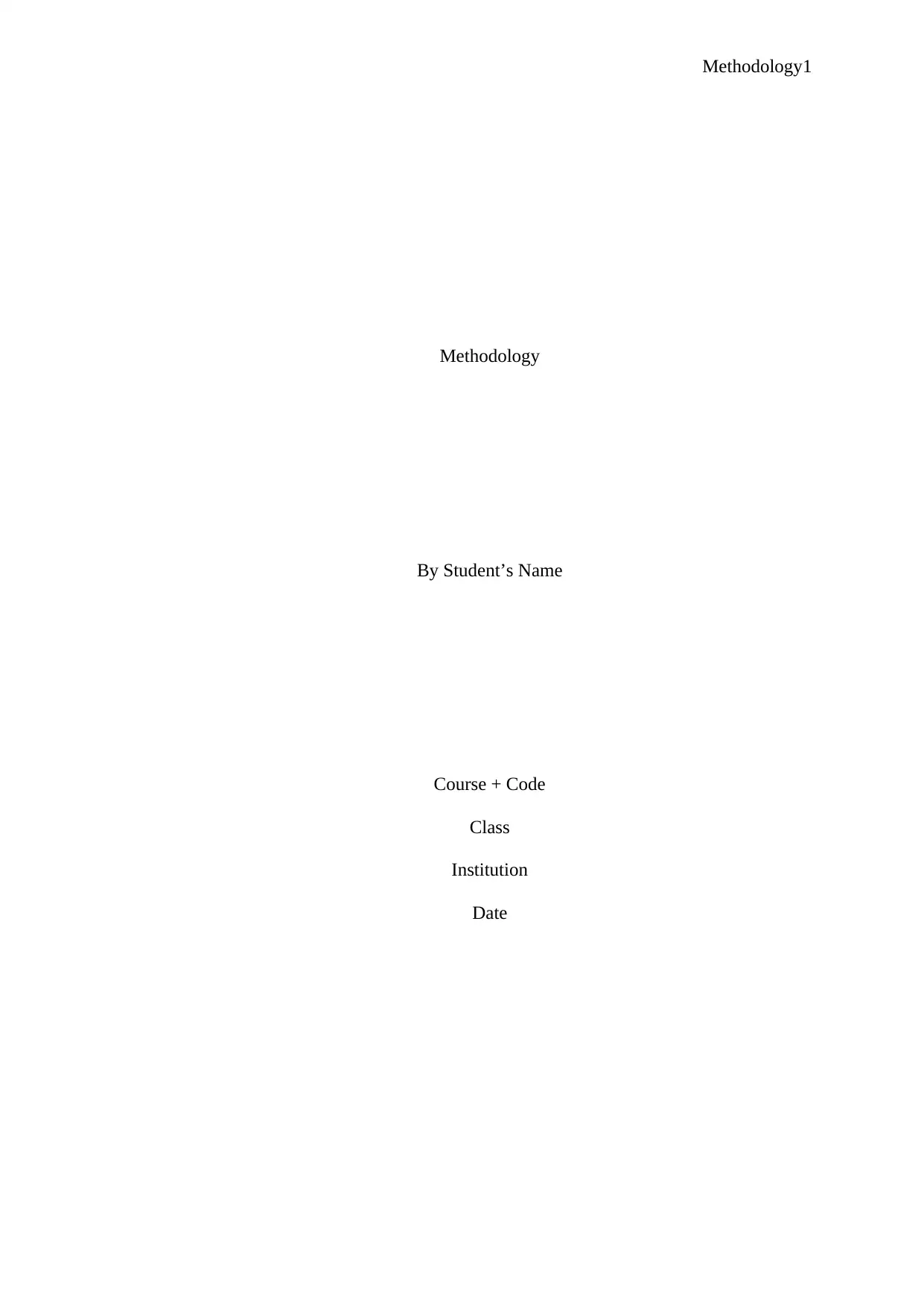
Methodology1
Methodology
By Student’s Name
Course + Code
Class
Institution
Date
Methodology
By Student’s Name
Course + Code
Class
Institution
Date
Paraphrase This Document
Need a fresh take? Get an instant paraphrase of this document with our AI Paraphraser
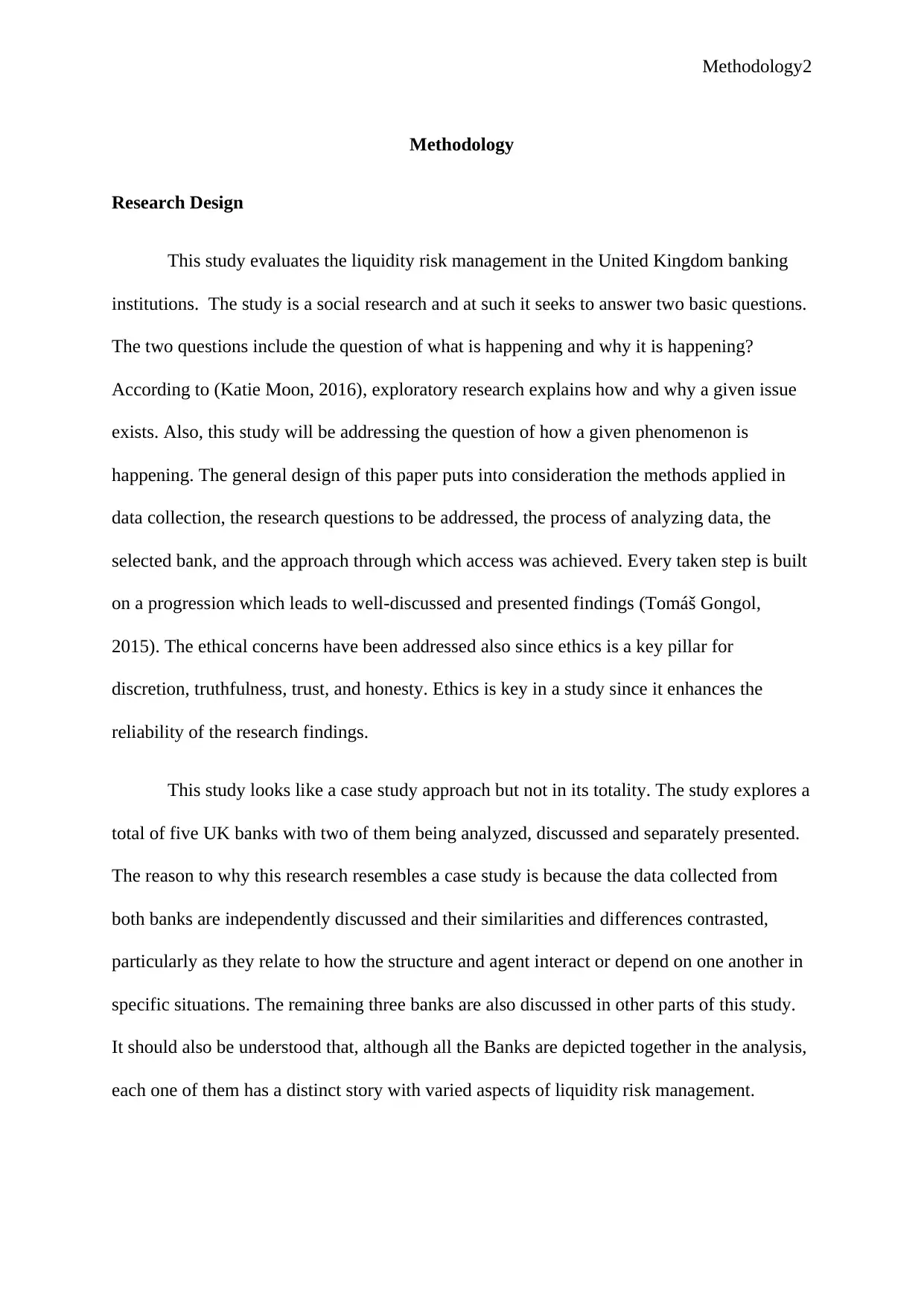
Methodology2
Methodology
Research Design
This study evaluates the liquidity risk management in the United Kingdom banking
institutions. The study is a social research and at such it seeks to answer two basic questions.
The two questions include the question of what is happening and why it is happening?
According to (Katie Moon, 2016), exploratory research explains how and why a given issue
exists. Also, this study will be addressing the question of how a given phenomenon is
happening. The general design of this paper puts into consideration the methods applied in
data collection, the research questions to be addressed, the process of analyzing data, the
selected bank, and the approach through which access was achieved. Every taken step is built
on a progression which leads to well-discussed and presented findings (Tomáš Gongol,
2015). The ethical concerns have been addressed also since ethics is a key pillar for
discretion, truthfulness, trust, and honesty. Ethics is key in a study since it enhances the
reliability of the research findings.
This study looks like a case study approach but not in its totality. The study explores a
total of five UK banks with two of them being analyzed, discussed and separately presented.
The reason to why this research resembles a case study is because the data collected from
both banks are independently discussed and their similarities and differences contrasted,
particularly as they relate to how the structure and agent interact or depend on one another in
specific situations. The remaining three banks are also discussed in other parts of this study.
It should also be understood that, although all the Banks are depicted together in the analysis,
each one of them has a distinct story with varied aspects of liquidity risk management.
Methodology
Research Design
This study evaluates the liquidity risk management in the United Kingdom banking
institutions. The study is a social research and at such it seeks to answer two basic questions.
The two questions include the question of what is happening and why it is happening?
According to (Katie Moon, 2016), exploratory research explains how and why a given issue
exists. Also, this study will be addressing the question of how a given phenomenon is
happening. The general design of this paper puts into consideration the methods applied in
data collection, the research questions to be addressed, the process of analyzing data, the
selected bank, and the approach through which access was achieved. Every taken step is built
on a progression which leads to well-discussed and presented findings (Tomáš Gongol,
2015). The ethical concerns have been addressed also since ethics is a key pillar for
discretion, truthfulness, trust, and honesty. Ethics is key in a study since it enhances the
reliability of the research findings.
This study looks like a case study approach but not in its totality. The study explores a
total of five UK banks with two of them being analyzed, discussed and separately presented.
The reason to why this research resembles a case study is because the data collected from
both banks are independently discussed and their similarities and differences contrasted,
particularly as they relate to how the structure and agent interact or depend on one another in
specific situations. The remaining three banks are also discussed in other parts of this study.
It should also be understood that, although all the Banks are depicted together in the analysis,
each one of them has a distinct story with varied aspects of liquidity risk management.
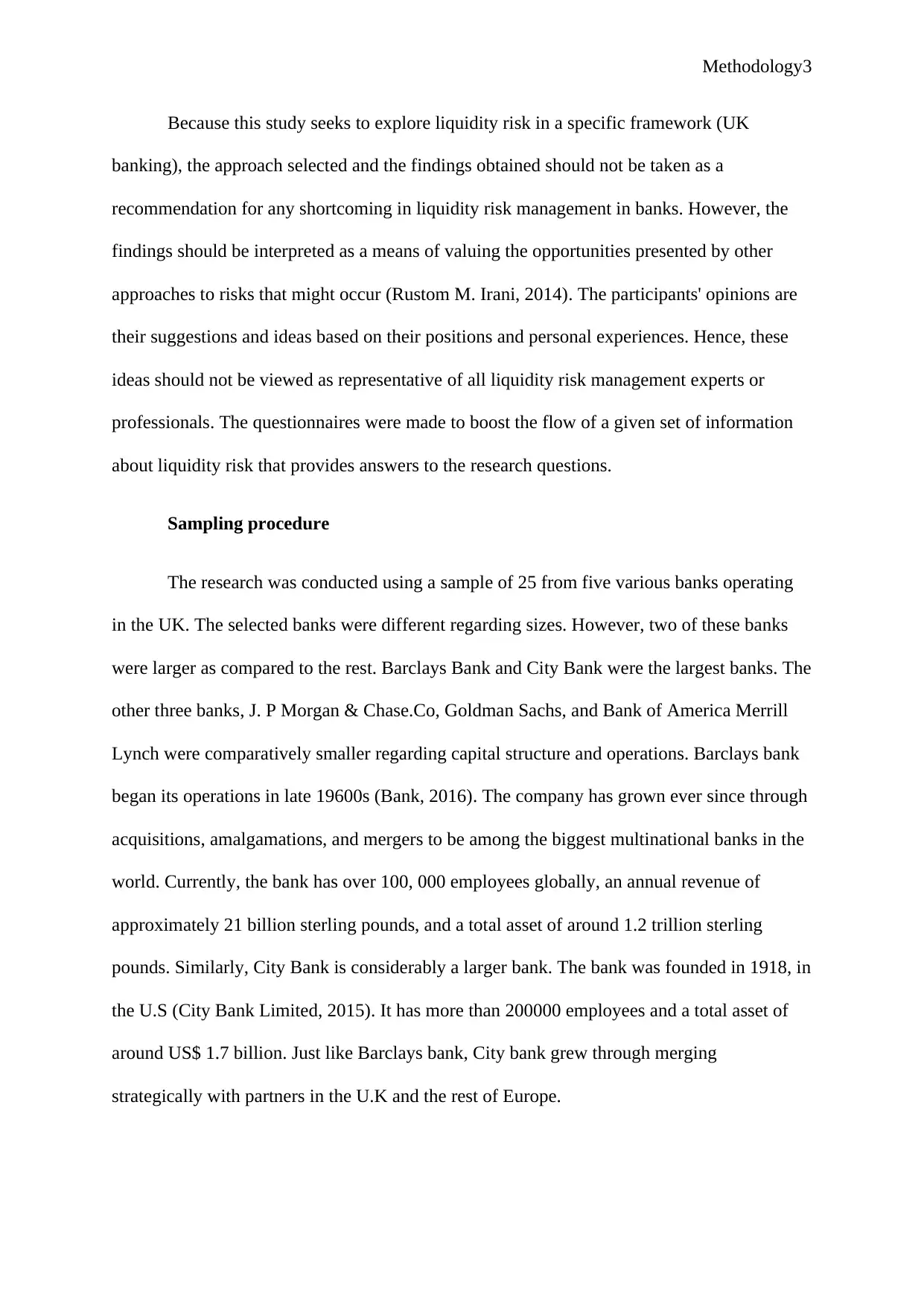
Methodology3
Because this study seeks to explore liquidity risk in a specific framework (UK
banking), the approach selected and the findings obtained should not be taken as a
recommendation for any shortcoming in liquidity risk management in banks. However, the
findings should be interpreted as a means of valuing the opportunities presented by other
approaches to risks that might occur (Rustom M. Irani, 2014). The participants' opinions are
their suggestions and ideas based on their positions and personal experiences. Hence, these
ideas should not be viewed as representative of all liquidity risk management experts or
professionals. The questionnaires were made to boost the flow of a given set of information
about liquidity risk that provides answers to the research questions.
Sampling procedure
The research was conducted using a sample of 25 from five various banks operating
in the UK. The selected banks were different regarding sizes. However, two of these banks
were larger as compared to the rest. Barclays Bank and City Bank were the largest banks. The
other three banks, J. P Morgan & Chase.Co, Goldman Sachs, and Bank of America Merrill
Lynch were comparatively smaller regarding capital structure and operations. Barclays bank
began its operations in late 19600s (Bank, 2016). The company has grown ever since through
acquisitions, amalgamations, and mergers to be among the biggest multinational banks in the
world. Currently, the bank has over 100, 000 employees globally, an annual revenue of
approximately 21 billion sterling pounds, and a total asset of around 1.2 trillion sterling
pounds. Similarly, City Bank is considerably a larger bank. The bank was founded in 1918, in
the U.S (City Bank Limited, 2015). It has more than 200000 employees and a total asset of
around US$ 1.7 billion. Just like Barclays bank, City bank grew through merging
strategically with partners in the U.K and the rest of Europe.
Because this study seeks to explore liquidity risk in a specific framework (UK
banking), the approach selected and the findings obtained should not be taken as a
recommendation for any shortcoming in liquidity risk management in banks. However, the
findings should be interpreted as a means of valuing the opportunities presented by other
approaches to risks that might occur (Rustom M. Irani, 2014). The participants' opinions are
their suggestions and ideas based on their positions and personal experiences. Hence, these
ideas should not be viewed as representative of all liquidity risk management experts or
professionals. The questionnaires were made to boost the flow of a given set of information
about liquidity risk that provides answers to the research questions.
Sampling procedure
The research was conducted using a sample of 25 from five various banks operating
in the UK. The selected banks were different regarding sizes. However, two of these banks
were larger as compared to the rest. Barclays Bank and City Bank were the largest banks. The
other three banks, J. P Morgan & Chase.Co, Goldman Sachs, and Bank of America Merrill
Lynch were comparatively smaller regarding capital structure and operations. Barclays bank
began its operations in late 19600s (Bank, 2016). The company has grown ever since through
acquisitions, amalgamations, and mergers to be among the biggest multinational banks in the
world. Currently, the bank has over 100, 000 employees globally, an annual revenue of
approximately 21 billion sterling pounds, and a total asset of around 1.2 trillion sterling
pounds. Similarly, City Bank is considerably a larger bank. The bank was founded in 1918, in
the U.S (City Bank Limited, 2015). It has more than 200000 employees and a total asset of
around US$ 1.7 billion. Just like Barclays bank, City bank grew through merging
strategically with partners in the U.K and the rest of Europe.
⊘ This is a preview!⊘
Do you want full access?
Subscribe today to unlock all pages.

Trusted by 1+ million students worldwide
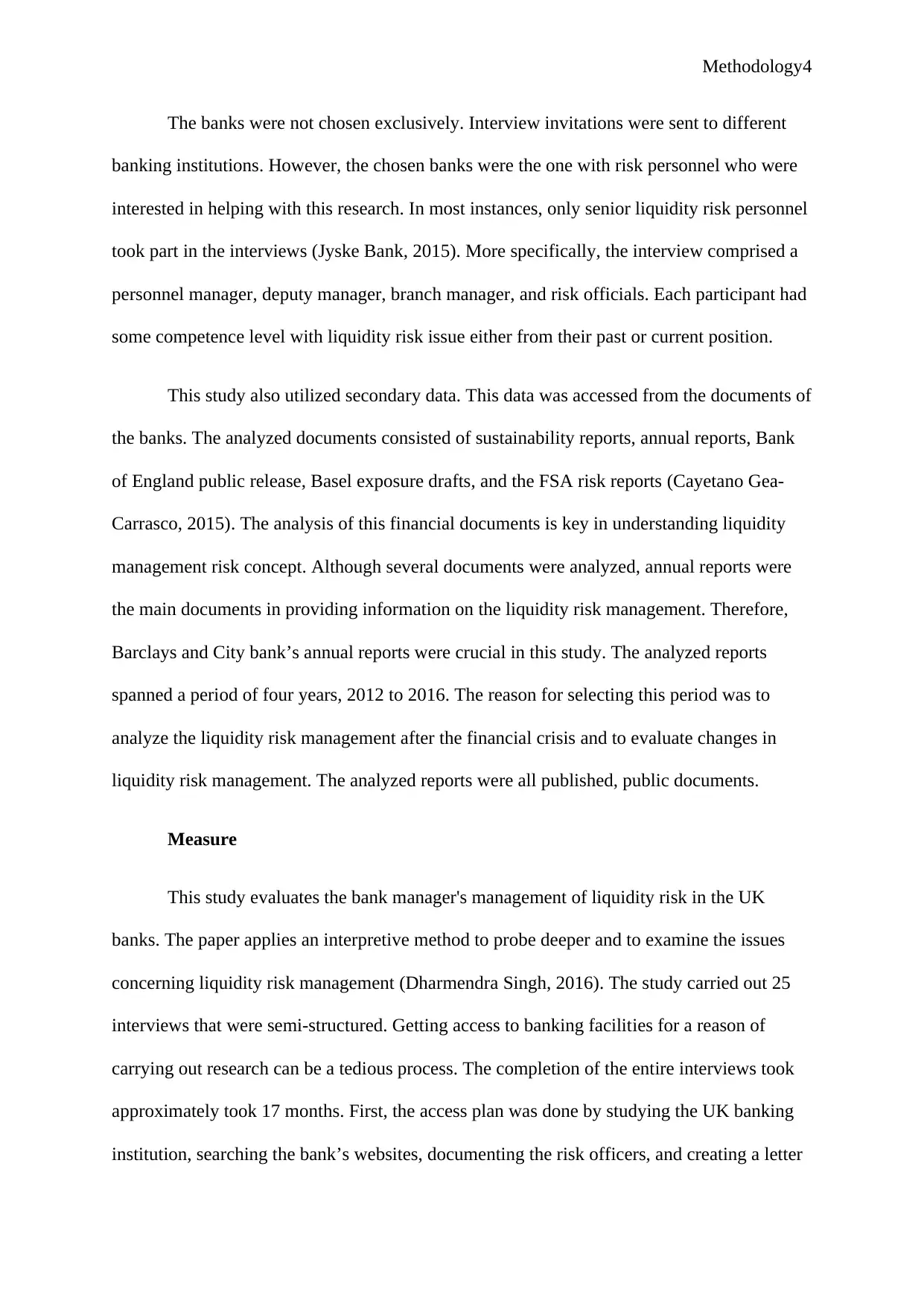
Methodology4
The banks were not chosen exclusively. Interview invitations were sent to different
banking institutions. However, the chosen banks were the one with risk personnel who were
interested in helping with this research. In most instances, only senior liquidity risk personnel
took part in the interviews (Jyske Bank, 2015). More specifically, the interview comprised a
personnel manager, deputy manager, branch manager, and risk officials. Each participant had
some competence level with liquidity risk issue either from their past or current position.
This study also utilized secondary data. This data was accessed from the documents of
the banks. The analyzed documents consisted of sustainability reports, annual reports, Bank
of England public release, Basel exposure drafts, and the FSA risk reports (Cayetano Gea-
Carrasco, 2015). The analysis of this financial documents is key in understanding liquidity
management risk concept. Although several documents were analyzed, annual reports were
the main documents in providing information on the liquidity risk management. Therefore,
Barclays and City bank’s annual reports were crucial in this study. The analyzed reports
spanned a period of four years, 2012 to 2016. The reason for selecting this period was to
analyze the liquidity risk management after the financial crisis and to evaluate changes in
liquidity risk management. The analyzed reports were all published, public documents.
Measure
This study evaluates the bank manager's management of liquidity risk in the UK
banks. The paper applies an interpretive method to probe deeper and to examine the issues
concerning liquidity risk management (Dharmendra Singh, 2016). The study carried out 25
interviews that were semi-structured. Getting access to banking facilities for a reason of
carrying out research can be a tedious process. The completion of the entire interviews took
approximately took 17 months. First, the access plan was done by studying the UK banking
institution, searching the bank’s websites, documenting the risk officers, and creating a letter
The banks were not chosen exclusively. Interview invitations were sent to different
banking institutions. However, the chosen banks were the one with risk personnel who were
interested in helping with this research. In most instances, only senior liquidity risk personnel
took part in the interviews (Jyske Bank, 2015). More specifically, the interview comprised a
personnel manager, deputy manager, branch manager, and risk officials. Each participant had
some competence level with liquidity risk issue either from their past or current position.
This study also utilized secondary data. This data was accessed from the documents of
the banks. The analyzed documents consisted of sustainability reports, annual reports, Bank
of England public release, Basel exposure drafts, and the FSA risk reports (Cayetano Gea-
Carrasco, 2015). The analysis of this financial documents is key in understanding liquidity
management risk concept. Although several documents were analyzed, annual reports were
the main documents in providing information on the liquidity risk management. Therefore,
Barclays and City bank’s annual reports were crucial in this study. The analyzed reports
spanned a period of four years, 2012 to 2016. The reason for selecting this period was to
analyze the liquidity risk management after the financial crisis and to evaluate changes in
liquidity risk management. The analyzed reports were all published, public documents.
Measure
This study evaluates the bank manager's management of liquidity risk in the UK
banks. The paper applies an interpretive method to probe deeper and to examine the issues
concerning liquidity risk management (Dharmendra Singh, 2016). The study carried out 25
interviews that were semi-structured. Getting access to banking facilities for a reason of
carrying out research can be a tedious process. The completion of the entire interviews took
approximately took 17 months. First, the access plan was done by studying the UK banking
institution, searching the bank’s websites, documenting the risk officers, and creating a letter
Paraphrase This Document
Need a fresh take? Get an instant paraphrase of this document with our AI Paraphraser
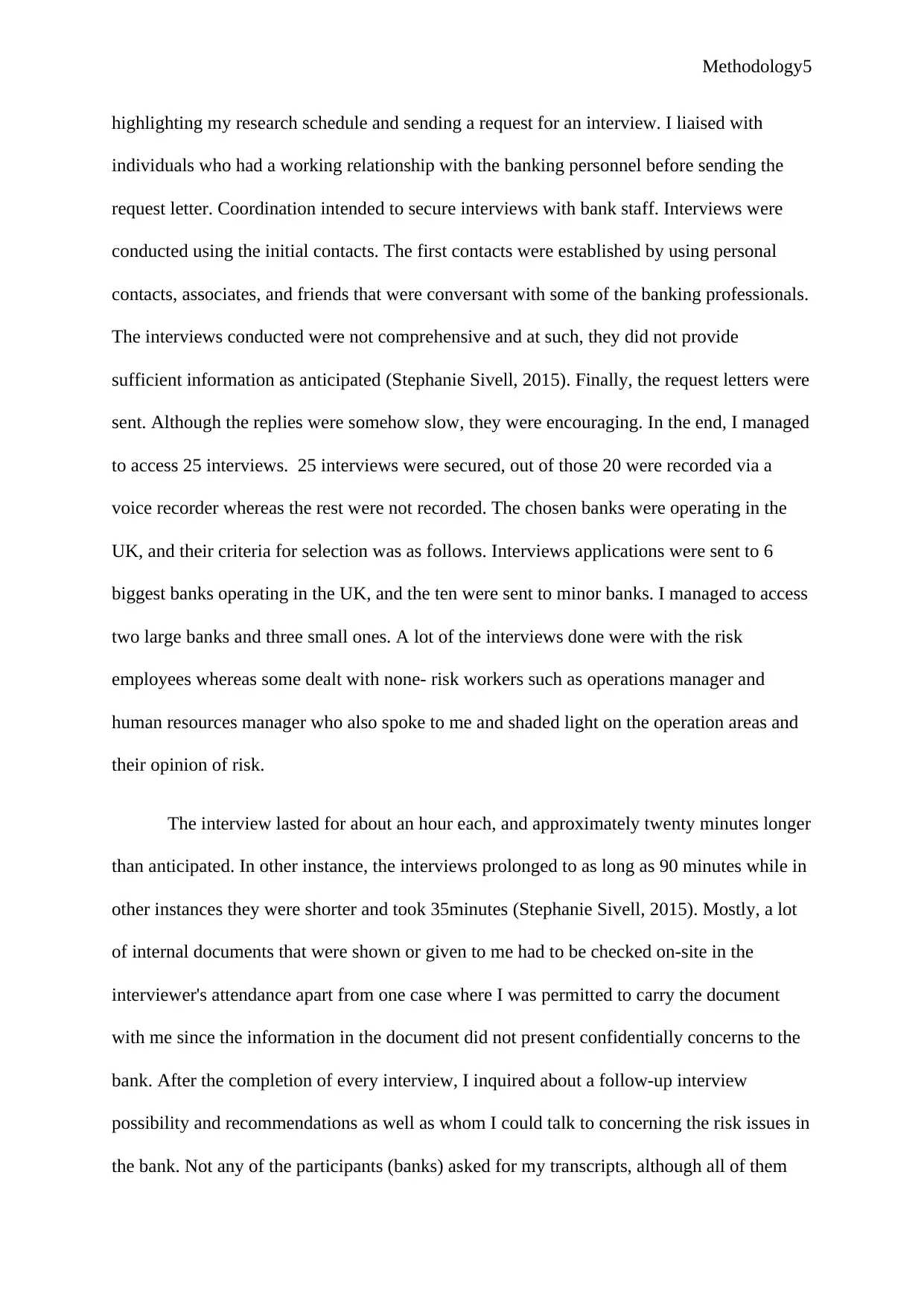
Methodology5
highlighting my research schedule and sending a request for an interview. I liaised with
individuals who had a working relationship with the banking personnel before sending the
request letter. Coordination intended to secure interviews with bank staff. Interviews were
conducted using the initial contacts. The first contacts were established by using personal
contacts, associates, and friends that were conversant with some of the banking professionals.
The interviews conducted were not comprehensive and at such, they did not provide
sufficient information as anticipated (Stephanie Sivell, 2015). Finally, the request letters were
sent. Although the replies were somehow slow, they were encouraging. In the end, I managed
to access 25 interviews. 25 interviews were secured, out of those 20 were recorded via a
voice recorder whereas the rest were not recorded. The chosen banks were operating in the
UK, and their criteria for selection was as follows. Interviews applications were sent to 6
biggest banks operating in the UK, and the ten were sent to minor banks. I managed to access
two large banks and three small ones. A lot of the interviews done were with the risk
employees whereas some dealt with none- risk workers such as operations manager and
human resources manager who also spoke to me and shaded light on the operation areas and
their opinion of risk.
The interview lasted for about an hour each, and approximately twenty minutes longer
than anticipated. In other instance, the interviews prolonged to as long as 90 minutes while in
other instances they were shorter and took 35minutes (Stephanie Sivell, 2015). Mostly, a lot
of internal documents that were shown or given to me had to be checked on-site in the
interviewer's attendance apart from one case where I was permitted to carry the document
with me since the information in the document did not present confidentially concerns to the
bank. After the completion of every interview, I inquired about a follow-up interview
possibility and recommendations as well as whom I could talk to concerning the risk issues in
the bank. Not any of the participants (banks) asked for my transcripts, although all of them
highlighting my research schedule and sending a request for an interview. I liaised with
individuals who had a working relationship with the banking personnel before sending the
request letter. Coordination intended to secure interviews with bank staff. Interviews were
conducted using the initial contacts. The first contacts were established by using personal
contacts, associates, and friends that were conversant with some of the banking professionals.
The interviews conducted were not comprehensive and at such, they did not provide
sufficient information as anticipated (Stephanie Sivell, 2015). Finally, the request letters were
sent. Although the replies were somehow slow, they were encouraging. In the end, I managed
to access 25 interviews. 25 interviews were secured, out of those 20 were recorded via a
voice recorder whereas the rest were not recorded. The chosen banks were operating in the
UK, and their criteria for selection was as follows. Interviews applications were sent to 6
biggest banks operating in the UK, and the ten were sent to minor banks. I managed to access
two large banks and three small ones. A lot of the interviews done were with the risk
employees whereas some dealt with none- risk workers such as operations manager and
human resources manager who also spoke to me and shaded light on the operation areas and
their opinion of risk.
The interview lasted for about an hour each, and approximately twenty minutes longer
than anticipated. In other instance, the interviews prolonged to as long as 90 minutes while in
other instances they were shorter and took 35minutes (Stephanie Sivell, 2015). Mostly, a lot
of internal documents that were shown or given to me had to be checked on-site in the
interviewer's attendance apart from one case where I was permitted to carry the document
with me since the information in the document did not present confidentially concerns to the
bank. After the completion of every interview, I inquired about a follow-up interview
possibility and recommendations as well as whom I could talk to concerning the risk issues in
the bank. Not any of the participants (banks) asked for my transcripts, although all of them
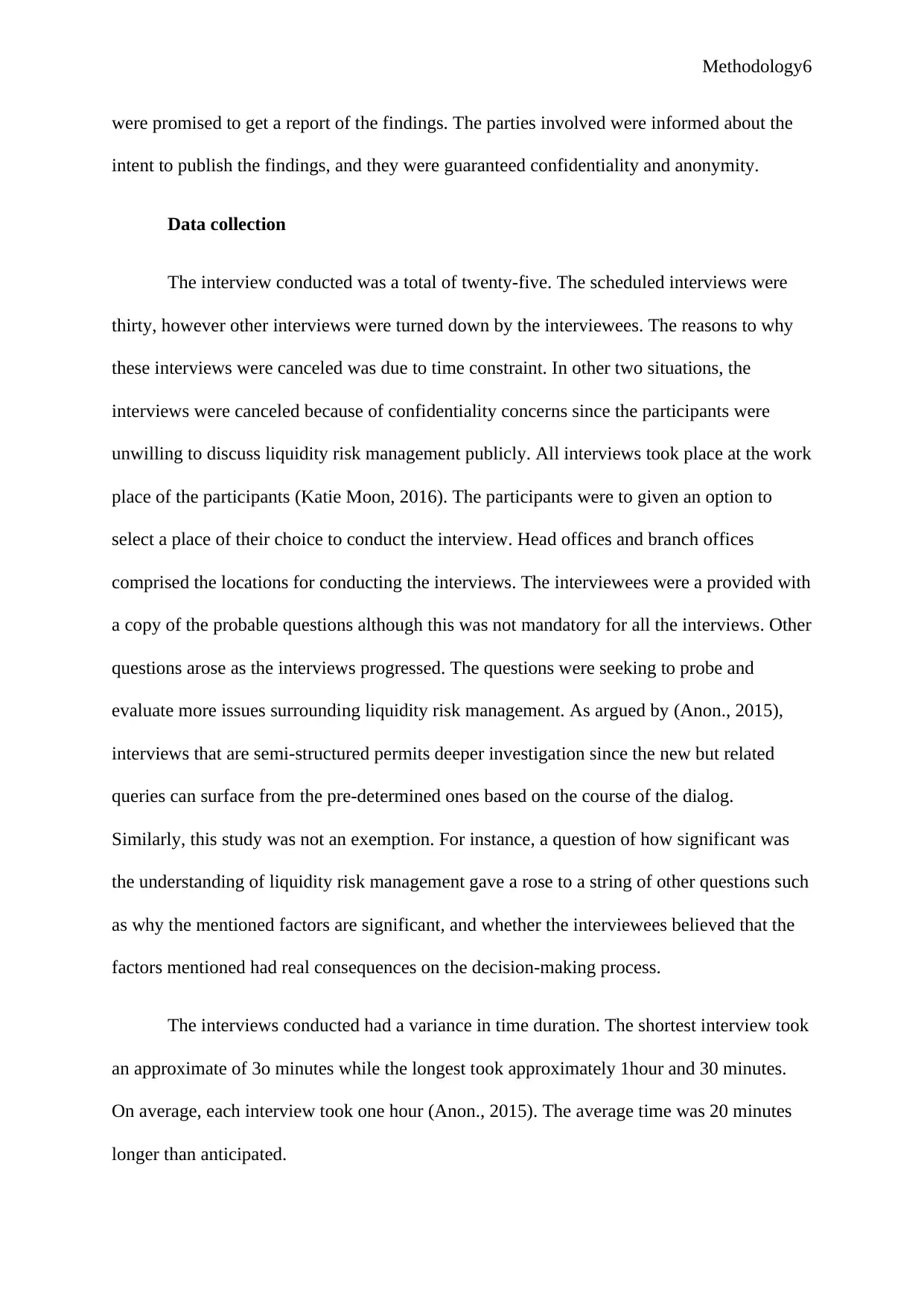
Methodology6
were promised to get a report of the findings. The parties involved were informed about the
intent to publish the findings, and they were guaranteed confidentiality and anonymity.
Data collection
The interview conducted was a total of twenty-five. The scheduled interviews were
thirty, however other interviews were turned down by the interviewees. The reasons to why
these interviews were canceled was due to time constraint. In other two situations, the
interviews were canceled because of confidentiality concerns since the participants were
unwilling to discuss liquidity risk management publicly. All interviews took place at the work
place of the participants (Katie Moon, 2016). The participants were to given an option to
select a place of their choice to conduct the interview. Head offices and branch offices
comprised the locations for conducting the interviews. The interviewees were a provided with
a copy of the probable questions although this was not mandatory for all the interviews. Other
questions arose as the interviews progressed. The questions were seeking to probe and
evaluate more issues surrounding liquidity risk management. As argued by (Anon., 2015),
interviews that are semi-structured permits deeper investigation since the new but related
queries can surface from the pre-determined ones based on the course of the dialog.
Similarly, this study was not an exemption. For instance, a question of how significant was
the understanding of liquidity risk management gave a rose to a string of other questions such
as why the mentioned factors are significant, and whether the interviewees believed that the
factors mentioned had real consequences on the decision-making process.
The interviews conducted had a variance in time duration. The shortest interview took
an approximate of 3o minutes while the longest took approximately 1hour and 30 minutes.
On average, each interview took one hour (Anon., 2015). The average time was 20 minutes
longer than anticipated.
were promised to get a report of the findings. The parties involved were informed about the
intent to publish the findings, and they were guaranteed confidentiality and anonymity.
Data collection
The interview conducted was a total of twenty-five. The scheduled interviews were
thirty, however other interviews were turned down by the interviewees. The reasons to why
these interviews were canceled was due to time constraint. In other two situations, the
interviews were canceled because of confidentiality concerns since the participants were
unwilling to discuss liquidity risk management publicly. All interviews took place at the work
place of the participants (Katie Moon, 2016). The participants were to given an option to
select a place of their choice to conduct the interview. Head offices and branch offices
comprised the locations for conducting the interviews. The interviewees were a provided with
a copy of the probable questions although this was not mandatory for all the interviews. Other
questions arose as the interviews progressed. The questions were seeking to probe and
evaluate more issues surrounding liquidity risk management. As argued by (Anon., 2015),
interviews that are semi-structured permits deeper investigation since the new but related
queries can surface from the pre-determined ones based on the course of the dialog.
Similarly, this study was not an exemption. For instance, a question of how significant was
the understanding of liquidity risk management gave a rose to a string of other questions such
as why the mentioned factors are significant, and whether the interviewees believed that the
factors mentioned had real consequences on the decision-making process.
The interviews conducted had a variance in time duration. The shortest interview took
an approximate of 3o minutes while the longest took approximately 1hour and 30 minutes.
On average, each interview took one hour (Anon., 2015). The average time was 20 minutes
longer than anticipated.
⊘ This is a preview!⊘
Do you want full access?
Subscribe today to unlock all pages.

Trusted by 1+ million students worldwide
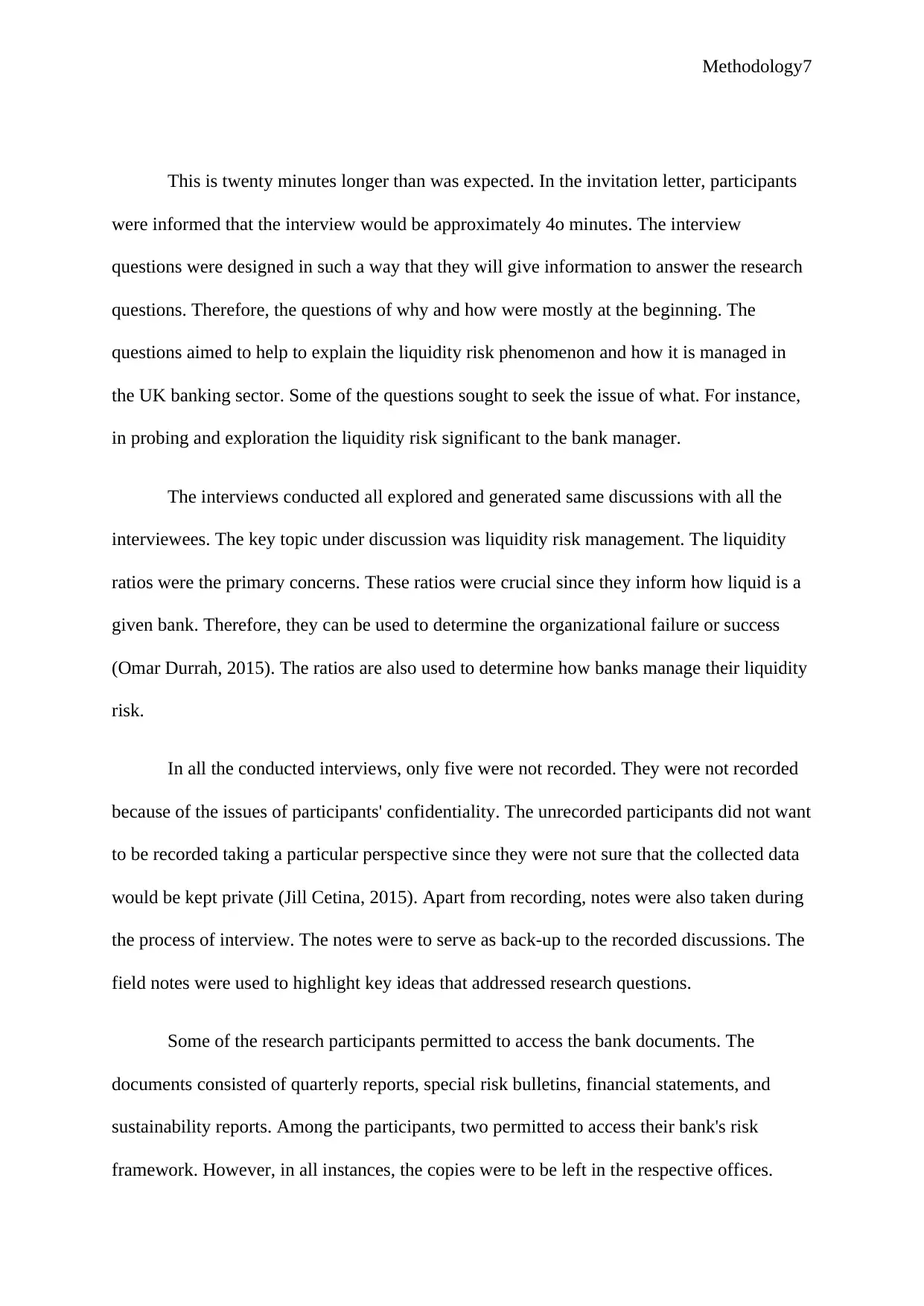
Methodology7
This is twenty minutes longer than was expected. In the invitation letter, participants
were informed that the interview would be approximately 4o minutes. The interview
questions were designed in such a way that they will give information to answer the research
questions. Therefore, the questions of why and how were mostly at the beginning. The
questions aimed to help to explain the liquidity risk phenomenon and how it is managed in
the UK banking sector. Some of the questions sought to seek the issue of what. For instance,
in probing and exploration the liquidity risk significant to the bank manager.
The interviews conducted all explored and generated same discussions with all the
interviewees. The key topic under discussion was liquidity risk management. The liquidity
ratios were the primary concerns. These ratios were crucial since they inform how liquid is a
given bank. Therefore, they can be used to determine the organizational failure or success
(Omar Durrah, 2015). The ratios are also used to determine how banks manage their liquidity
risk.
In all the conducted interviews, only five were not recorded. They were not recorded
because of the issues of participants' confidentiality. The unrecorded participants did not want
to be recorded taking a particular perspective since they were not sure that the collected data
would be kept private (Jill Cetina, 2015). Apart from recording, notes were also taken during
the process of interview. The notes were to serve as back-up to the recorded discussions. The
field notes were used to highlight key ideas that addressed research questions.
Some of the research participants permitted to access the bank documents. The
documents consisted of quarterly reports, special risk bulletins, financial statements, and
sustainability reports. Among the participants, two permitted to access their bank's risk
framework. However, in all instances, the copies were to be left in the respective offices.
This is twenty minutes longer than was expected. In the invitation letter, participants
were informed that the interview would be approximately 4o minutes. The interview
questions were designed in such a way that they will give information to answer the research
questions. Therefore, the questions of why and how were mostly at the beginning. The
questions aimed to help to explain the liquidity risk phenomenon and how it is managed in
the UK banking sector. Some of the questions sought to seek the issue of what. For instance,
in probing and exploration the liquidity risk significant to the bank manager.
The interviews conducted all explored and generated same discussions with all the
interviewees. The key topic under discussion was liquidity risk management. The liquidity
ratios were the primary concerns. These ratios were crucial since they inform how liquid is a
given bank. Therefore, they can be used to determine the organizational failure or success
(Omar Durrah, 2015). The ratios are also used to determine how banks manage their liquidity
risk.
In all the conducted interviews, only five were not recorded. They were not recorded
because of the issues of participants' confidentiality. The unrecorded participants did not want
to be recorded taking a particular perspective since they were not sure that the collected data
would be kept private (Jill Cetina, 2015). Apart from recording, notes were also taken during
the process of interview. The notes were to serve as back-up to the recorded discussions. The
field notes were used to highlight key ideas that addressed research questions.
Some of the research participants permitted to access the bank documents. The
documents consisted of quarterly reports, special risk bulletins, financial statements, and
sustainability reports. Among the participants, two permitted to access their bank's risk
framework. However, in all instances, the copies were to be left in the respective offices.
Paraphrase This Document
Need a fresh take? Get an instant paraphrase of this document with our AI Paraphraser
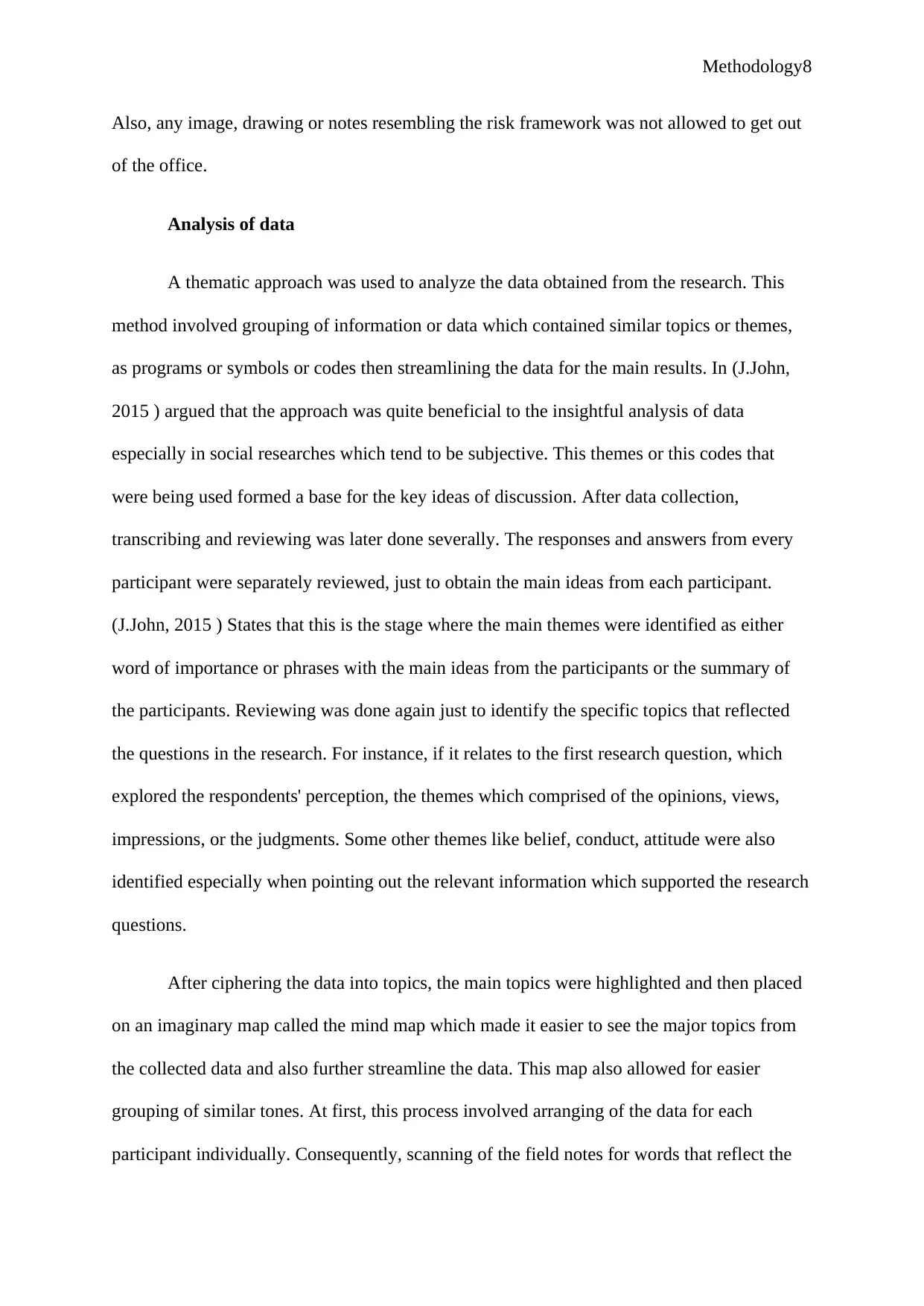
Methodology8
Also, any image, drawing or notes resembling the risk framework was not allowed to get out
of the office.
Analysis of data
A thematic approach was used to analyze the data obtained from the research. This
method involved grouping of information or data which contained similar topics or themes,
as programs or symbols or codes then streamlining the data for the main results. In (J.John,
2015 ) argued that the approach was quite beneficial to the insightful analysis of data
especially in social researches which tend to be subjective. This themes or this codes that
were being used formed a base for the key ideas of discussion. After data collection,
transcribing and reviewing was later done severally. The responses and answers from every
participant were separately reviewed, just to obtain the main ideas from each participant.
(J.John, 2015 ) States that this is the stage where the main themes were identified as either
word of importance or phrases with the main ideas from the participants or the summary of
the participants. Reviewing was done again just to identify the specific topics that reflected
the questions in the research. For instance, if it relates to the first research question, which
explored the respondents' perception, the themes which comprised of the opinions, views,
impressions, or the judgments. Some other themes like belief, conduct, attitude were also
identified especially when pointing out the relevant information which supported the research
questions.
After ciphering the data into topics, the main topics were highlighted and then placed
on an imaginary map called the mind map which made it easier to see the major topics from
the collected data and also further streamline the data. This map also allowed for easier
grouping of similar tones. At first, this process involved arranging of the data for each
participant individually. Consequently, scanning of the field notes for words that reflect the
Also, any image, drawing or notes resembling the risk framework was not allowed to get out
of the office.
Analysis of data
A thematic approach was used to analyze the data obtained from the research. This
method involved grouping of information or data which contained similar topics or themes,
as programs or symbols or codes then streamlining the data for the main results. In (J.John,
2015 ) argued that the approach was quite beneficial to the insightful analysis of data
especially in social researches which tend to be subjective. This themes or this codes that
were being used formed a base for the key ideas of discussion. After data collection,
transcribing and reviewing was later done severally. The responses and answers from every
participant were separately reviewed, just to obtain the main ideas from each participant.
(J.John, 2015 ) States that this is the stage where the main themes were identified as either
word of importance or phrases with the main ideas from the participants or the summary of
the participants. Reviewing was done again just to identify the specific topics that reflected
the questions in the research. For instance, if it relates to the first research question, which
explored the respondents' perception, the themes which comprised of the opinions, views,
impressions, or the judgments. Some other themes like belief, conduct, attitude were also
identified especially when pointing out the relevant information which supported the research
questions.
After ciphering the data into topics, the main topics were highlighted and then placed
on an imaginary map called the mind map which made it easier to see the major topics from
the collected data and also further streamline the data. This map also allowed for easier
grouping of similar tones. At first, this process involved arranging of the data for each
participant individually. Consequently, scanning of the field notes for words that reflect the
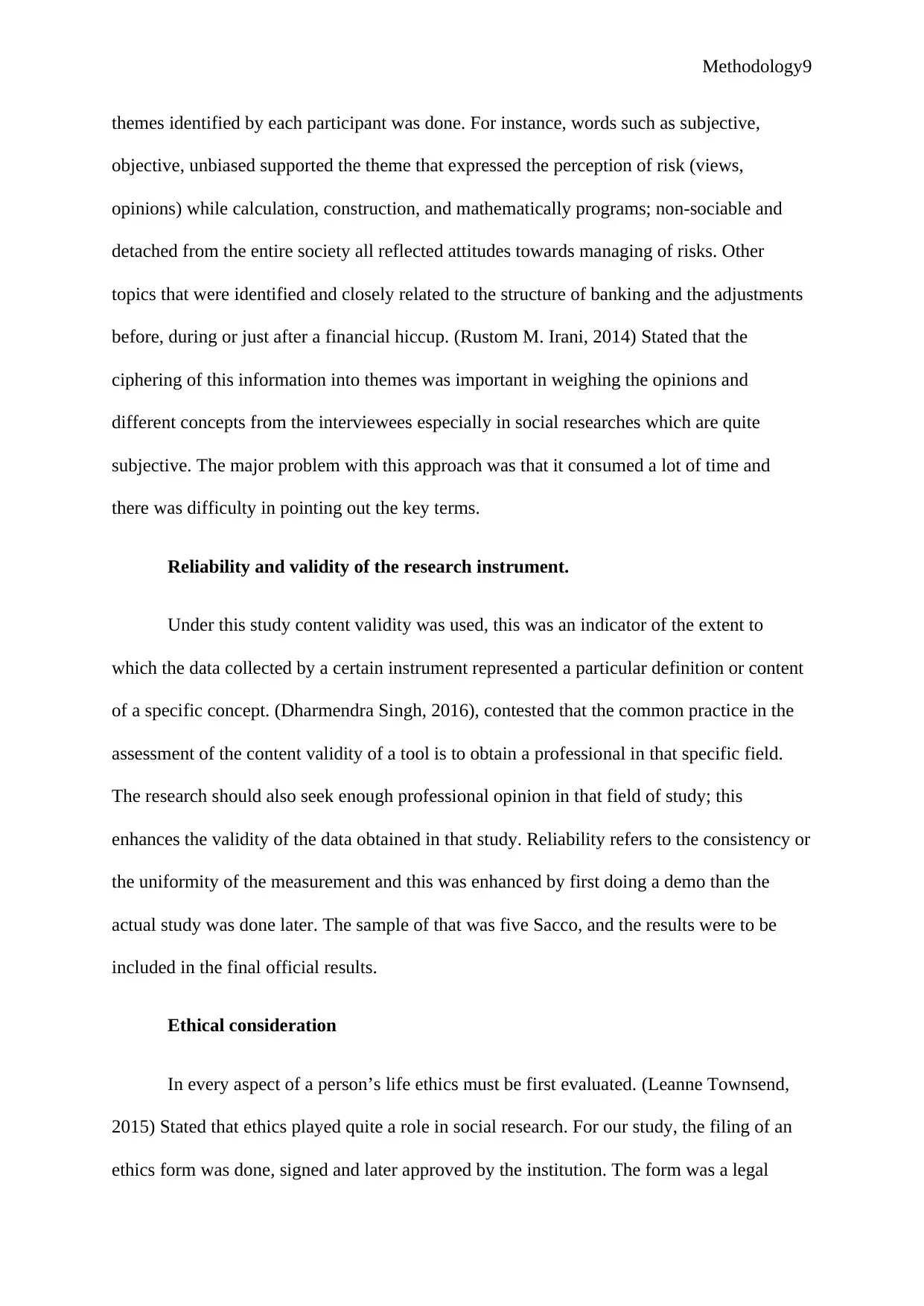
Methodology9
themes identified by each participant was done. For instance, words such as subjective,
objective, unbiased supported the theme that expressed the perception of risk (views,
opinions) while calculation, construction, and mathematically programs; non-sociable and
detached from the entire society all reflected attitudes towards managing of risks. Other
topics that were identified and closely related to the structure of banking and the adjustments
before, during or just after a financial hiccup. (Rustom M. Irani, 2014) Stated that the
ciphering of this information into themes was important in weighing the opinions and
different concepts from the interviewees especially in social researches which are quite
subjective. The major problem with this approach was that it consumed a lot of time and
there was difficulty in pointing out the key terms.
Reliability and validity of the research instrument.
Under this study content validity was used, this was an indicator of the extent to
which the data collected by a certain instrument represented a particular definition or content
of a specific concept. (Dharmendra Singh, 2016), contested that the common practice in the
assessment of the content validity of a tool is to obtain a professional in that specific field.
The research should also seek enough professional opinion in that field of study; this
enhances the validity of the data obtained in that study. Reliability refers to the consistency or
the uniformity of the measurement and this was enhanced by first doing a demo than the
actual study was done later. The sample of that was five Sacco, and the results were to be
included in the final official results.
Ethical consideration
In every aspect of a person’s life ethics must be first evaluated. (Leanne Townsend,
2015) Stated that ethics played quite a role in social research. For our study, the filing of an
ethics form was done, signed and later approved by the institution. The form was a legal
themes identified by each participant was done. For instance, words such as subjective,
objective, unbiased supported the theme that expressed the perception of risk (views,
opinions) while calculation, construction, and mathematically programs; non-sociable and
detached from the entire society all reflected attitudes towards managing of risks. Other
topics that were identified and closely related to the structure of banking and the adjustments
before, during or just after a financial hiccup. (Rustom M. Irani, 2014) Stated that the
ciphering of this information into themes was important in weighing the opinions and
different concepts from the interviewees especially in social researches which are quite
subjective. The major problem with this approach was that it consumed a lot of time and
there was difficulty in pointing out the key terms.
Reliability and validity of the research instrument.
Under this study content validity was used, this was an indicator of the extent to
which the data collected by a certain instrument represented a particular definition or content
of a specific concept. (Dharmendra Singh, 2016), contested that the common practice in the
assessment of the content validity of a tool is to obtain a professional in that specific field.
The research should also seek enough professional opinion in that field of study; this
enhances the validity of the data obtained in that study. Reliability refers to the consistency or
the uniformity of the measurement and this was enhanced by first doing a demo than the
actual study was done later. The sample of that was five Sacco, and the results were to be
included in the final official results.
Ethical consideration
In every aspect of a person’s life ethics must be first evaluated. (Leanne Townsend,
2015) Stated that ethics played quite a role in social research. For our study, the filing of an
ethics form was done, signed and later approved by the institution. The form was a legal
⊘ This is a preview!⊘
Do you want full access?
Subscribe today to unlock all pages.

Trusted by 1+ million students worldwide
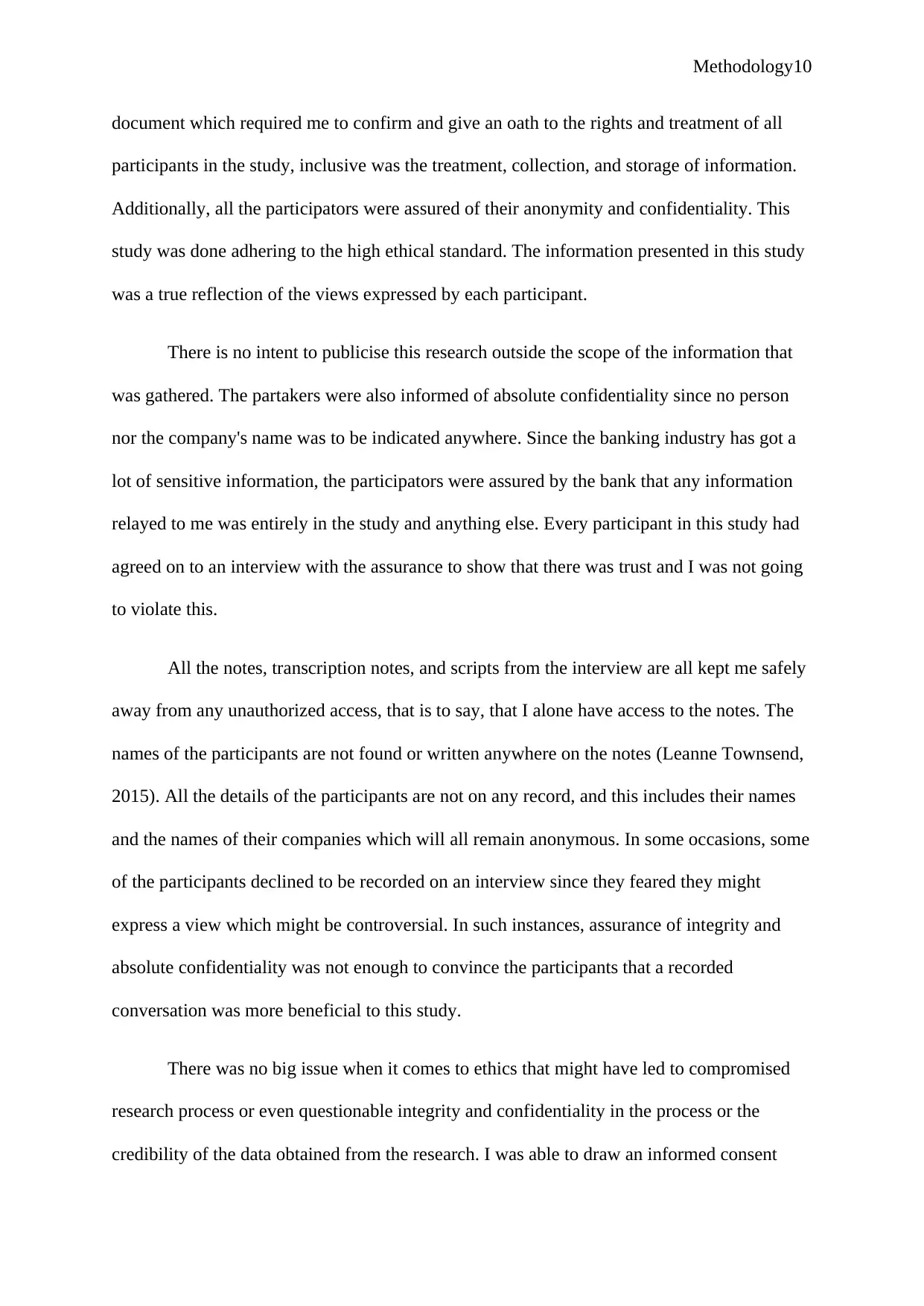
Methodology10
document which required me to confirm and give an oath to the rights and treatment of all
participants in the study, inclusive was the treatment, collection, and storage of information.
Additionally, all the participators were assured of their anonymity and confidentiality. This
study was done adhering to the high ethical standard. The information presented in this study
was a true reflection of the views expressed by each participant.
There is no intent to publicise this research outside the scope of the information that
was gathered. The partakers were also informed of absolute confidentiality since no person
nor the company's name was to be indicated anywhere. Since the banking industry has got a
lot of sensitive information, the participators were assured by the bank that any information
relayed to me was entirely in the study and anything else. Every participant in this study had
agreed on to an interview with the assurance to show that there was trust and I was not going
to violate this.
All the notes, transcription notes, and scripts from the interview are all kept me safely
away from any unauthorized access, that is to say, that I alone have access to the notes. The
names of the participants are not found or written anywhere on the notes (Leanne Townsend,
2015). All the details of the participants are not on any record, and this includes their names
and the names of their companies which will all remain anonymous. In some occasions, some
of the participants declined to be recorded on an interview since they feared they might
express a view which might be controversial. In such instances, assurance of integrity and
absolute confidentiality was not enough to convince the participants that a recorded
conversation was more beneficial to this study.
There was no big issue when it comes to ethics that might have led to compromised
research process or even questionable integrity and confidentiality in the process or the
credibility of the data obtained from the research. I was able to draw an informed consent
document which required me to confirm and give an oath to the rights and treatment of all
participants in the study, inclusive was the treatment, collection, and storage of information.
Additionally, all the participators were assured of their anonymity and confidentiality. This
study was done adhering to the high ethical standard. The information presented in this study
was a true reflection of the views expressed by each participant.
There is no intent to publicise this research outside the scope of the information that
was gathered. The partakers were also informed of absolute confidentiality since no person
nor the company's name was to be indicated anywhere. Since the banking industry has got a
lot of sensitive information, the participators were assured by the bank that any information
relayed to me was entirely in the study and anything else. Every participant in this study had
agreed on to an interview with the assurance to show that there was trust and I was not going
to violate this.
All the notes, transcription notes, and scripts from the interview are all kept me safely
away from any unauthorized access, that is to say, that I alone have access to the notes. The
names of the participants are not found or written anywhere on the notes (Leanne Townsend,
2015). All the details of the participants are not on any record, and this includes their names
and the names of their companies which will all remain anonymous. In some occasions, some
of the participants declined to be recorded on an interview since they feared they might
express a view which might be controversial. In such instances, assurance of integrity and
absolute confidentiality was not enough to convince the participants that a recorded
conversation was more beneficial to this study.
There was no big issue when it comes to ethics that might have led to compromised
research process or even questionable integrity and confidentiality in the process or the
credibility of the data obtained from the research. I was able to draw an informed consent
Paraphrase This Document
Need a fresh take? Get an instant paraphrase of this document with our AI Paraphraser
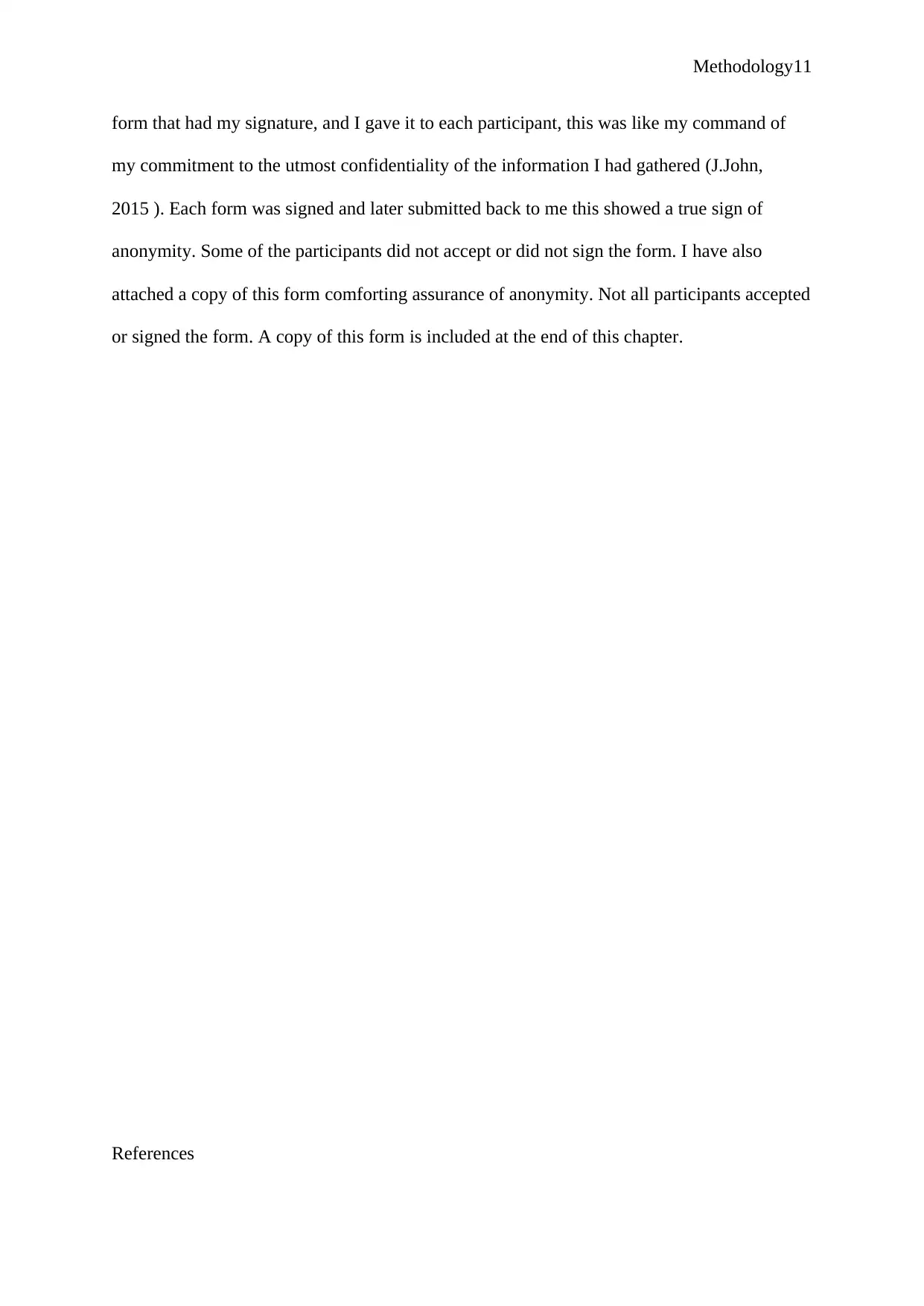
Methodology11
form that had my signature, and I gave it to each participant, this was like my command of
my commitment to the utmost confidentiality of the information I had gathered (J.John,
2015 ). Each form was signed and later submitted back to me this showed a true sign of
anonymity. Some of the participants did not accept or did not sign the form. I have also
attached a copy of this form comforting assurance of anonymity. Not all participants accepted
or signed the form. A copy of this form is included at the end of this chapter.
References
form that had my signature, and I gave it to each participant, this was like my command of
my commitment to the utmost confidentiality of the information I had gathered (J.John,
2015 ). Each form was signed and later submitted back to me this showed a true sign of
anonymity. Some of the participants did not accept or did not sign the form. I have also
attached a copy of this form comforting assurance of anonymity. Not all participants accepted
or signed the form. A copy of this form is included at the end of this chapter.
References
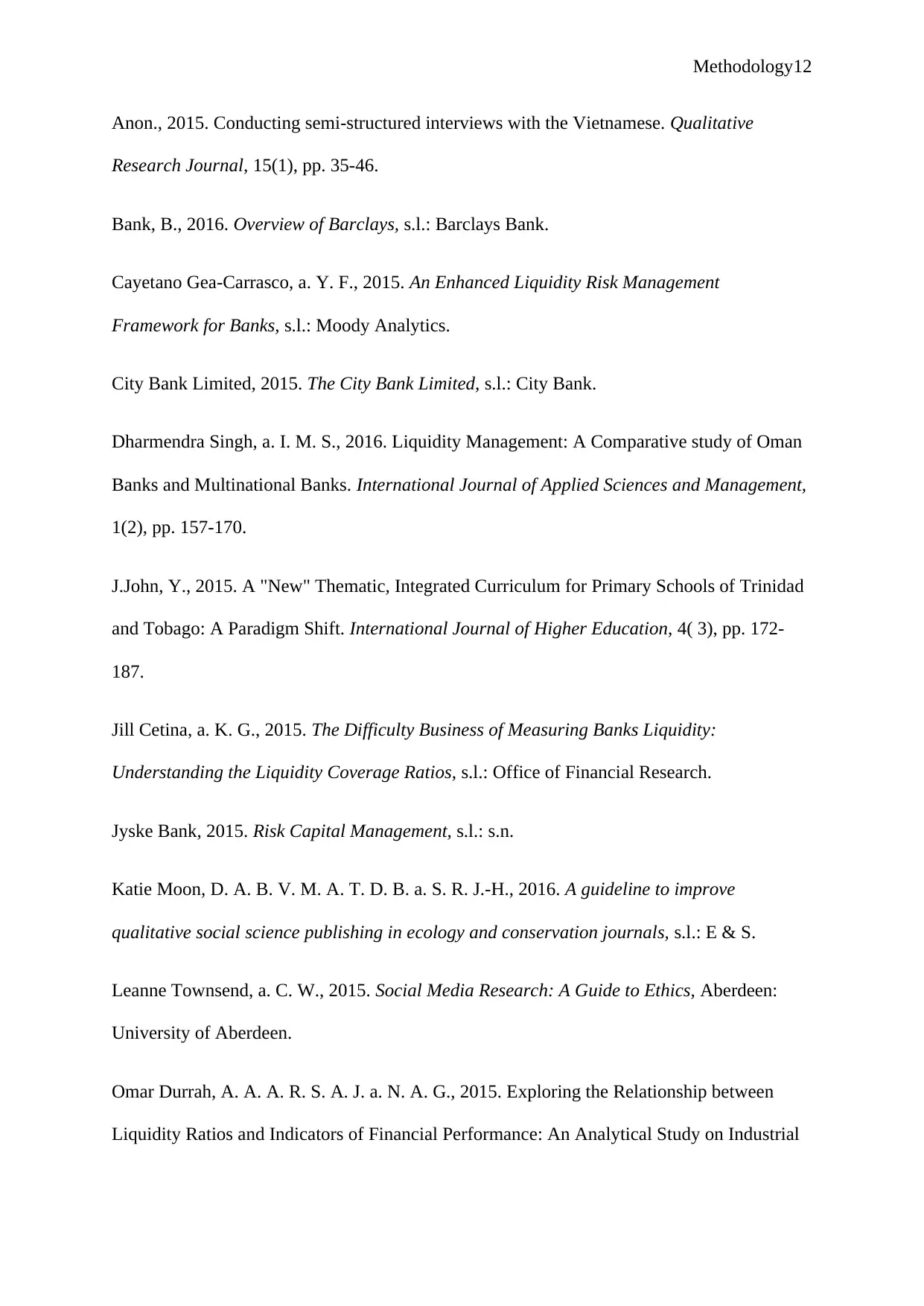
Methodology12
Anon., 2015. Conducting semi-structured interviews with the Vietnamese. Qualitative
Research Journal, 15(1), pp. 35-46.
Bank, B., 2016. Overview of Barclays, s.l.: Barclays Bank.
Cayetano Gea-Carrasco, a. Y. F., 2015. An Enhanced Liquidity Risk Management
Framework for Banks, s.l.: Moody Analytics.
City Bank Limited, 2015. The City Bank Limited, s.l.: City Bank.
Dharmendra Singh, a. I. M. S., 2016. Liquidity Management: A Comparative study of Oman
Banks and Multinational Banks. International Journal of Applied Sciences and Management,
1(2), pp. 157-170.
J.John, Y., 2015. A "New" Thematic, Integrated Curriculum for Primary Schools of Trinidad
and Tobago: A Paradigm Shift. International Journal of Higher Education, 4( 3), pp. 172-
187.
Jill Cetina, a. K. G., 2015. The Difficulty Business of Measuring Banks Liquidity:
Understanding the Liquidity Coverage Ratios, s.l.: Office of Financial Research.
Jyske Bank, 2015. Risk Capital Management, s.l.: s.n.
Katie Moon, D. A. B. V. M. A. T. D. B. a. S. R. J.-H., 2016. A guideline to improve
qualitative social science publishing in ecology and conservation journals, s.l.: E & S.
Leanne Townsend, a. C. W., 2015. Social Media Research: A Guide to Ethics, Aberdeen:
University of Aberdeen.
Omar Durrah, A. A. A. R. S. A. J. a. N. A. G., 2015. Exploring the Relationship between
Liquidity Ratios and Indicators of Financial Performance: An Analytical Study on Industrial
Anon., 2015. Conducting semi-structured interviews with the Vietnamese. Qualitative
Research Journal, 15(1), pp. 35-46.
Bank, B., 2016. Overview of Barclays, s.l.: Barclays Bank.
Cayetano Gea-Carrasco, a. Y. F., 2015. An Enhanced Liquidity Risk Management
Framework for Banks, s.l.: Moody Analytics.
City Bank Limited, 2015. The City Bank Limited, s.l.: City Bank.
Dharmendra Singh, a. I. M. S., 2016. Liquidity Management: A Comparative study of Oman
Banks and Multinational Banks. International Journal of Applied Sciences and Management,
1(2), pp. 157-170.
J.John, Y., 2015. A "New" Thematic, Integrated Curriculum for Primary Schools of Trinidad
and Tobago: A Paradigm Shift. International Journal of Higher Education, 4( 3), pp. 172-
187.
Jill Cetina, a. K. G., 2015. The Difficulty Business of Measuring Banks Liquidity:
Understanding the Liquidity Coverage Ratios, s.l.: Office of Financial Research.
Jyske Bank, 2015. Risk Capital Management, s.l.: s.n.
Katie Moon, D. A. B. V. M. A. T. D. B. a. S. R. J.-H., 2016. A guideline to improve
qualitative social science publishing in ecology and conservation journals, s.l.: E & S.
Leanne Townsend, a. C. W., 2015. Social Media Research: A Guide to Ethics, Aberdeen:
University of Aberdeen.
Omar Durrah, A. A. A. R. S. A. J. a. N. A. G., 2015. Exploring the Relationship between
Liquidity Ratios and Indicators of Financial Performance: An Analytical Study on Industrial
⊘ This is a preview!⊘
Do you want full access?
Subscribe today to unlock all pages.

Trusted by 1+ million students worldwide
1 out of 13
Related Documents
Your All-in-One AI-Powered Toolkit for Academic Success.
+13062052269
info@desklib.com
Available 24*7 on WhatsApp / Email
![[object Object]](/_next/static/media/star-bottom.7253800d.svg)
Unlock your academic potential
Copyright © 2020–2025 A2Z Services. All Rights Reserved. Developed and managed by ZUCOL.




